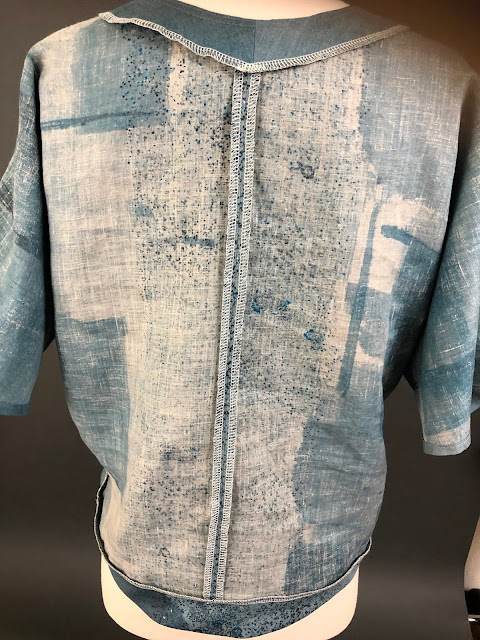It is still summer here in the Midwest and I'm still working through my linen stash. I really don't follow a system when it comes to deciding which fabric to sew. I just pick the one that was inspiring to me at the moment. Like this lovely Nani Iro linen.
 |
| It's hard to see from the photo but this lightweight Japanese fabric has the most beautiful design that features a double border print and variegated shades of blue arranged in geometric fashion. |
After browsing through the myriad of inspiring garment photos posted on Instagram, I decided to make my own version of the Papercut "Pinnacle Top" pattern.
About the pattern:
The Pinnacle top pattern is available in the Papercut pattern website as a paper pattern or PDF file. It features an oversized cropped top which can be sewn in one of three ways:
Variation 1: deep V neckline with short or wrist length sleeve
Variation 2: round neckline with binding and back ties with short or wrist length sleeve
Variation 3: sweater with neck band and sleeve cuffs
The first two variations will work well with woven fabrics and the third one with knit.
I made view 1. It only consists of three pattern pieces--the body, the triangular inset and the neck facing.
Variation 1: deep V neckline with short or wrist length sleeve
Variation 2: round neckline with binding and back ties with short or wrist length sleeve
Variation 3: sweater with neck band and sleeve cuffs
The first two variations will work well with woven fabrics and the third one with knit.
I made view 1. It only consists of three pattern pieces--the body, the triangular inset and the neck facing.
Unlike the typical top pattern, this one does not have a front and back pattern piece. Instead, it has only one body pattern piece, the back and front being connected already by the sleeve.
 |
| After much rearranging, I decided to just put the border print on the center back. |
 |
| See the center back? That is made of two border prints sewn along the lengthwise grain. |
 |
| Here are the cut fabric pieces. It's like a giant jigsaw puzzle! |
Construction:
Although the top itself was easy to sew owing to the simplicity of the lines, I still had to grapple with some issues which necessitated some fiddling with.
•Very Deep V-Neckline
It is indeed mentioned in the pattern website that the neckline is deep. Looking at finished garments posted on Instagram, a lot of them were worn with cami. When I tried on the muslin, I found out for myself how deep it was. I definitely could not wear the top as is so I had to make adjustments on my pattern pieces.
 |
| I raised the neckline by 1.5". I had to redraw the edge that would be attached to the center triangular inset. |
 |
| I also needed to adjust the triangular pattern piece on the cut side leaving the center fold line as is. |
 |
| A closer look at the adjustment needed to be made on the triangular piece. |
 |
| Not to forget the neck facing. Since I raised the neckline by 1.5", I had to shorten the neck facing by same amount. |
This is definitely more wearable for me!
•Center Front Seam I created
Since I pieced the fabric I used for the triangular center inset, I created an unwanted seam in the middle. No biggie but I didn't like how it looked so I decided go camouflage it with some decorative stitches.
 |
| After testing a variety of decorative stitches on a scrap piece of fabric, I settled for this one on my Juki F600. |
 |
| I used a wash away stabilizer for decorative stitching. It definitely made a difference in the quality of the final stitches. |
 |
| I used a light blue embroidery thread which went really well with the fabric. |
 |
•Bottom Hem
I tested different methods of hemming the bottom as I did not like how the front center hem was sticking out. Although it seems that the top was supposed to look that way judging from most of the photos I have seen of the finished project, mine was doing so in an unattractive way. I'm guessing it must be due to the seamed center of the triangular inset.
 |
| First try: simple folded hem. I stitched a 5/8" guideline and folded the hem to the inside. |
 |
| Second try: I sewed a wide bias cut hem facing and turned to the inside. |
 |
| Third and last try: I sewed a 4" wide bias cut hem band and sewed in place. |
 |
| This is the view from the right side. |
I decided on the third method. After pressing the band in place, it looked good on the top and improved the issue a bit. It still stuck out but in a more graceful manner. And it's a plus that I was able to add 2" hem to the cropped top.
And now photos of the finished garment!






































